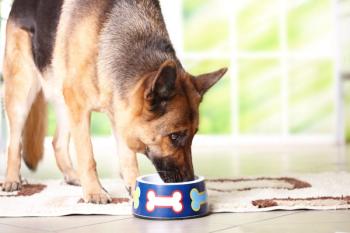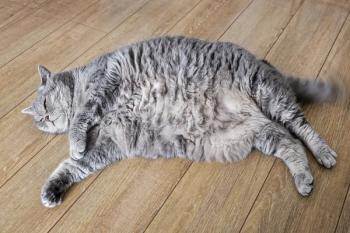
Dear Kara: Urinary problems (Sponsored by Hill's Pet Nutrition)
Kara answers questions about urinary problems
I volunteer weekends at a shelter and continue to see homeless cats brought in by frustrated owners who say they can't get their cats to use their litter box. We typically perform a complete urinalysis, but the results are usually negative for infection or crystals. With these cases, is it a good idea to have the new owners put the cats on a therapeutic food such as Hill's® Prescription Diet® c/d® Multicare Feline pet food?
For the first step, I always recommend the veterinarian perform a physical exam and a complete urinalysis. However, in cases like these, some form of diagnostic imaging, such as abdominal radiography, is needed to exclude uroliths. If results of the urinalysis and diagnostic imaging do not reveal a cause, the cat most likely has feline idiopathic cystitis (FIC)—a common cause of lower urinary tract signs in cats. A multimodal approach including environmental enrichment, litter box management, and feeding moist pet food is appropriate for cats with FIC. Feeding Hill's ® Prescription Diet ® c/d® Multicare Feline pet food, which contains omega-3 fatty acids, will help break the inflammatory cycle in FIC.
I'm often stumped when clients ask me what to do when they have cats on different therapeutic foods (e.g., one cat on Hill's® Prescription Diet® c/d® Multicare Feline pet food and one cat on Hill's® Prescription Diet® w/d® Feline pet food). How would you handle this situation?
This is a common question from owners with multiple pets. The answer depends upon the disease and the food recommended by the veterinarian. If you are managing cats with feline lower urinary tract disease (FLUTD) and weight problems, feeding them canned Hill's® Prescription Diet® w/d® Feline pet food is appropriate because the target urine pH for both products is 6.2 to 6.4. Also, meal feeding vs. free feeding is ideal for this scenario. Remember that a therapeutic food is recommended for a pet to improve a specific disease condition; therefore, it is best to educate owners about the recommendation, disease, and need for the specific food so they are more likely to continue feeding the food to the cat.
If an owner has one dog or cat that needs Hill's® Prescription Diet® s/d® pet food, can she feed that food to all of her animals? How long can they stay on it?
Hill's® Prescription Diet® s/d® pet food is formulated to dissolve struvite uroliths in dogs and cats. If a recommendation has been made to begin s/d, and there are multiple animals in the house, only the pet diagnosed with struvite urolithiasis should be fed s/d. It should be fed for a specific amount of time, and, as with all therapeutic foods, is only recommended under the supervision of a veterinarian.
While the pet is eating s/d, frequently (every two to four weeks) recheck the pet's urine and monitor its uroliths using survey radiographs. Following the dissolution of the uroliths, continue feeding s/d for one month and gradually transition the pet to a struvite maintenance food for long-term management of struvite urolithiasis.
A cat's urolith composition analysis results show a mixed urolith comprised of calcium oxalate and struvite. What would you recommend to nutritionally manage this type of a urolith?
This is not an uncommon finding. Fortunately, the healthcare team can provide sound recommendations for nutritional management of this mixed urolith. To manage the stone, the healthcare team should reduce the building blocks of crystals and uroliths and break the cycle of inflammation associated with FLUTD. Recommending Hill's® Prescription Diet® c/d® Multicare Feline pet food provides a food that has controlled levels of magnesium, calcium, phosphorus, and oxalate; added potassium citrate for inhibiting stone formation; and includes high levels of omega-3 fatty acids to help manage inflammation.
A client asked if it is a good idea to encourage her cat to drink more, She heard this promotes a healthy urinary tract. What are some suggestions to get cats to drink more?
It is true that increasing the cat's water intake may help maintain a healthy urinary tract. Compared with dry pet food, feeding moist pet food has been associated with an increase in total daily water intake, urine volume, and clinical improvement in cats with FIC. Hill's® Science Diet® and Prescription Diet® cat foods are available in moist formulations. Educate owners to switch from dry to moist pet food gradually to increase acceptance of the new pet food. To insure a positive transition, offer the moist food in a separate dish next to the dry food, and gradually decrease the amount of dry food and increase the moist food. Dividing meals into smaller and more frequent meals will help increase the daily water intake. I also suggest adding ice cubes to the cat's water, using unique water bowls, novel water fountains, and adding broth to food as ways to increase daily water intake.
What should we recommend for fat cats with struvite crystals?
Cats that are obese or prone to obesity certainly have different nutritional needs. Obese cats with a history of struvite-induced disease (i.e., uroliths or urethral plugs) can be managed with Hill's® Prescription Diet® w/d® Feline pet food or Hill's® Prescription Diet® r/d® Feline pet food. Both are low in magnesium and fat, high in carnitine, and help burn fat while increasing lean muscle mass. Fiber is increased in w/d feline and is high in r/d feline to aid satiety. The target urine pH for r/d and w/d is 6.2 to 6.4, which is the range recommended for decreasing the risk of struvite crystal formation.
Kara M. Burns, MS, MEd, LVT Veterinary Technician Specialist Hill's Pet Nutrition
Kara M. Burns, MS, MEd, LVT
© 2008 Hill's Pet Nutrition, Inc. All rights reserved. ®/TM Trademarks owned by Hill's Pet Nutrition, Inc. To view this and other issues of Dear Kara, visit
Newsletter
From exam room tips to practice management insights, get trusted veterinary news delivered straight to your inbox—subscribe to dvm360.




